Prevalence and Pattern of Tobacco use Among Students of Niger Delta University
Owonaro A Peter*, Daughter E Owonaro Awala ,Sounyo Adekola, and Favour Obi
Department of Clinical Pharmacy and Pharmacy Practice, Faculty of Pharmacy, Niger Delta University, Nigeria.
Submission: May 08, 2024; Published: May 24, 2024
*Corresponding author: Owonaro A Peter, Department of Clinical Pharmacy and Pharmacy Practice, Faculty of Pharmacy, Niger Delta University, Nigeria. Email: owonaropeter@gmail.com
How to cite this article: Owonaro A Peter*, Daughter E Owonaro Awala ,Sounyo Adekola, and Favour Obi. Prevalence and Pattern of Tobacco use Among Students of Niger Delta University. JOJ Pub Health. 2024; 9(1): 555753. DOI: 10.19080/JOJPH.2024.09.555753
Abstract
This study is aimed at investigating the prevalence and pattern of tobacco use among students at Niger Delta University. The qualitative and quantitative approach was used to explore the pattern of tobacco usage. The target population consisted of all students that make use of tobacco and tobacco products in Niger Delta University. All the students who use tobacco were eligible for this study irrespective of their academic level, gender, and age. This study reveals that cigarette is the most common tobacco product used. The results suggest that most of the participants were in their mid-twenties (20-25 years), while the majority, 40% were in their third year (300 level). The majority of 76% did not use tobacco before the start of their university education. Also, 13% feel it is not possible to quit the use of tobacco while 92% will accept help to smoke smoking if made available. As regards the knowledge of the health impact of tobacco, 94% acknowledged that it is a harmful practice and that there is no safe form of tobacco. However, the knowledge of tobacco products and their adverse health effects varies among respondents from different studies and scientific fields. Furthermore, most of the participants claimed that using tobacco impacts their academic performance. This study recommends that banning the sale of tobacco and tobacco products on and off campus could be beneficial, as it would help reduce the number of deaths and illnesses caused by smoking.
Keywords: Harmful effects; Decrease life expectancy; Deaths and illnesses; Tobacco; Smoking behavior; Tobacco hazards; Secondhand smoke; Lung cancer and cardiovascular disease
Abbreviations: FCTC: Framework Convention on Tobacco Control; NCTA: National Tobacco Control Act; CVD: Cardiovascular Disease
Introduction
Tobacco smoking ranked second among the leading risk factors for early death and disability (Emerole et al., 2013). It has been termed a worldwide silent epidemic (Lynskey and Hall, 2000; Ferrante et al., 2013), killing more than 7 million people on an annual basis (Ferrante et al., 2013), and remains the leading cause of preventable deaths globally (WHO, 2018). Eniojukan and Owonaro (2015) opined that smoking may decrease life expectancy by 7 to 10 years. Smoking of tobacco is on the increase despite the documented deleterious health impacts on the cardiovascular and respiratory systems, and other disorders (Abikoye et al., 2013). Cigarettes, cannabis, and shisha smoking have been on the rise among youths globally (Lynskey and Hall, 2000; Amorha et al., 2017), of which university students are not excluded. Although previously considered a problem in Europe and North America, recent evidence portrays a global problem and that it has be come highly prevalent in low-income countries despite increasing knowledge of its harmful effects (Forouzanfar et al., 2016).
In Nigeria, studies have also noted the increasing proportion of young people engaged in smoking (Ukwayi et al., 2012; Emerole et al., 2013). Cigarettes contain over 7000 chemical substances and 69 out of them are implicated in the development of carcinoma (Eniojukan et al., 2015). Cannabis is a generic term used to denote the several psychoactive preparations of the cannabis plant. The most obvious short-term health effect of cannabis is intoxication marked by disturbances in the level of consciousness, impaired cognition, and motor coordination that often results in road traffic accidents and fatalities, anxiety and psychosis symptoms, acute effects on lungs and airways, and acute cardiovascular effects (WHO, 2016). Shisha is a form of tobacco smoke in which the vapor passes through water before inhalation (Bartecchi et al., 1995; WHO, 2005). Shisha smoking is a threat to both the oral and general health of the public. It has been associated with adverse oral health outcomes (Bibars et al., 2015; El-Zaatari et al., 2015). Independent studies have been conducted on the prevalence of smoking, awareness, and predisposing factors among university students (Aslam et al., 2014; Lynskey and Hall, 2000; Amorha et al., 2017).
Students may start to smoke as a way of expressing their transition into adulthood1 and, consequently, are more likely to smoke than the general population [1]. Some students may smoke to fit in, as they are more likely to become involved with different kinds of sociocultural groups while on campus. If a student initiate smoking, it becomes difficult to stop and the student is likely to develop a regular smoking pattern for life. According to Senol et al., (2016) among the original non-smokers who enter university, one-third become regular smokers by the end of their studies. Masjedi et al., (2018) also showed that the prevalence of smoking is significantly higher in students in their last year of study compared with those in their first year. The estimated cost of tobacco in low- and middle-income countries is 10% of the student’s income, so the money paid for tobacco is diverted from nutrition, education, and medical care [2].
In Nigeria, smoking behavior has also been influenced by the nation’s switch from a tobacco-producing to tobacco consuming state [3], and deliberate efforts by tobacco companies to stall governmental control policies for economic reasons [4]. Tobacco commerce predisposes over 220.9 million Nigerians including students to cardiac problems, lung cancer, oral cancer, mental disorders, and other health conditions [5] World Population Review, 2022 Educational attainment proved inconsequential as a high smoking rate was observed among students, including medical students. According to [2], cigarette abuse was alarmingly at 17.9% among medical proteges, while students of neutral disciplines revealed 19.1% of tobacco smoked [5]. Nigeria endorsed the 2005 six-element policy of the WHO Framework Convention on Tobacco Control (FCTC) known as MPOWER to regulate tobacco consumption [4]. MPOWER aimed at Monitoring tobacco usage and deterrence policies (M), Protecting the populace from tobacco emissions (P), Offering aid on tobacco cessation (O), Warmings on tobacco hazards (W), Enforcing restrictions on tobacco advertisement (E), and Raising tobacco levy (R) (WHO, 2021). In consolidation, Nigeria enacted the National Tobacco Control Act (NCTA) a decade later [4]. This study, therefore, aims at analyzing the epidemiology of tobacco use among students aged 15 years and older. The rationale for adopting Nigeria is informed by the nation’s tobacco accessibility and the vulnerable population. Logically, effective preventive and control measures in Nigeria would become a model for countries with low populations and accessibility to tobacco.
Main Objectives of the Study
This study is aimed at investigating the prevalence and pattern of tobacco use among students at Niger Delta University. Specifically, this study will.
• Determine the prevalence of tobacco smoking among male and female.
• Examine the types of tobacco used.
• Determine the academic performance among smokers.
Methods
Study design
A cross-sectional design was carried used
Study population
The target population consisted of all students that make use of tobacco and tobacco products in Niger Delta University.
Inclusion criteria
All the students who use tobacco were eligible for this study irrespective of their academic level, gender, age, etc. Students who were previous smokers and users of tobacco were accepted in this study.
Exclusion criteria
People who were not students at the time of this study were not included. Also, students who do not smoke or use tobacco in any form were not included in this study.
Data collection
Before data collection, the principal investigator had a brief chat with the participants to explain the purpose of the study and to request permission to conduct the study. Thereafter, willing participants were allowed to choose a convenient time and dates for the interviews and filling of the questionnaires. The participants were also informed that they had the option to withdraw from the study at any time. The interviews were conducted in private homes and on campus. The duration of the interviews was between 10 and 15 minutes. This allowed the researcher to ask questions, probe further, and obtain clarity on the information shared by the participants.
Data were collected using English and pidgin language, depending on the participants’ language of preference through indepth individual interviews with the participants. One hundred questionnaires were collected from the participants.
Results
[Table 1], [Figure 1 & 2], [Table 2], [Figure 3 & 4]
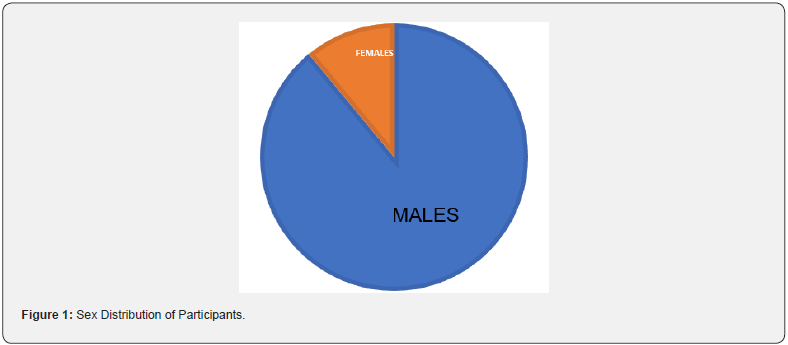
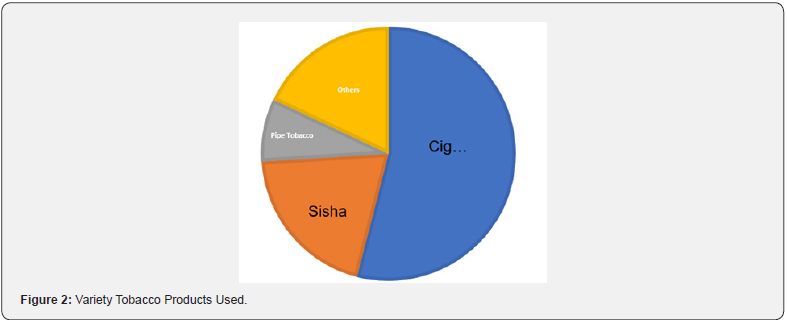
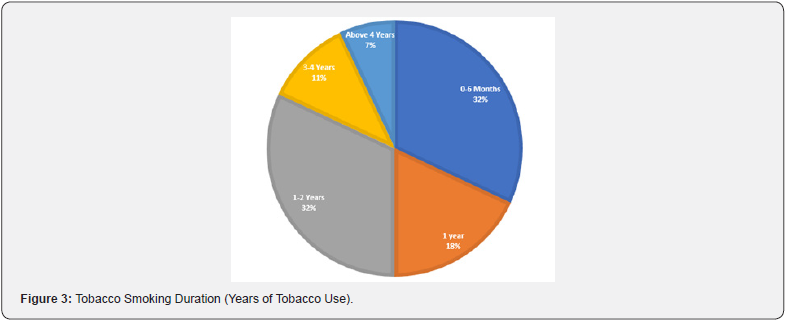
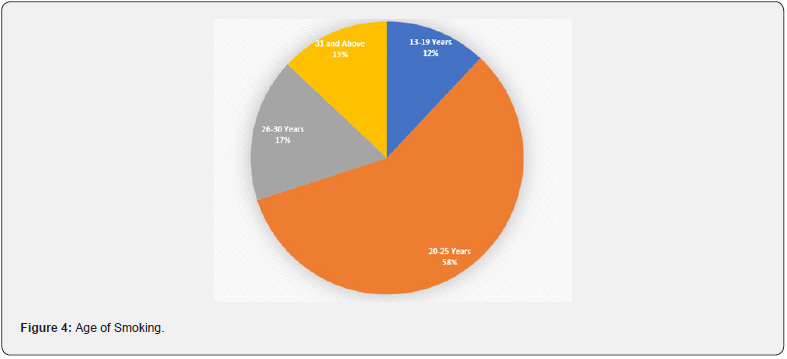
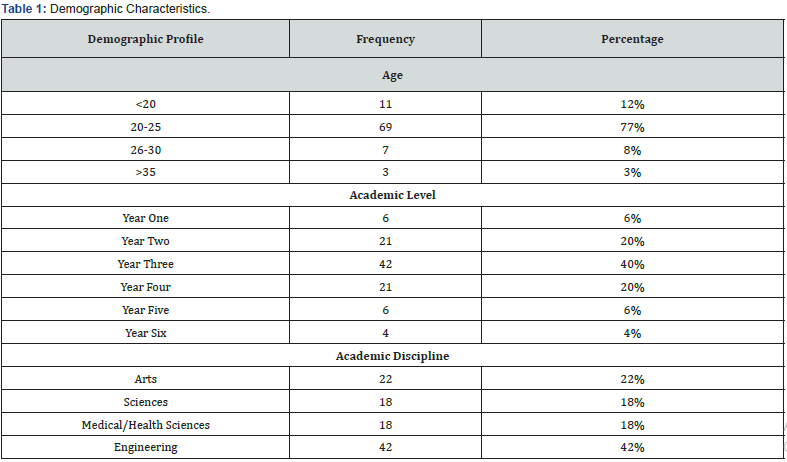
Discussion
This study was conducted to examine the tobacco smoking patterns among students at the Niger Delta University. This study collected data from different genders, age ranges, academic levels, and academic disciplines. The results for the demographic characteristics presented in Table 1 suggest that most of the participants were in their mid-twenties (20-25 years), while a majority of 40% were om their third year (300 level). As regards their academic discipline many of the tobacco users were in the faculty of engineering (42%). A majority of 89% of the participants were males, while 11% were females. In this survey, the gender of the respondents did not affect knowledge and patterns of tobacco usage. In contrast, Itanyi et al. [6] reported that there were more male smokers and that males had better knowledge levels. The higher percentage of males could be due to the social acceptance of smoking among males, a sense of maturity (a symbol of masculinity), and peer influence. The lower prevalence of female smokers could be due to family values, cultural norms, or religion [6]. In contrast to gender, respondents’ age and the time they started using tobacco products influenced their knowledge. Older respondents had better knowledge, as did those who started smoking later, probably because they had more time to become informed and were aware of more advertisements about the harmful effects of smoking.
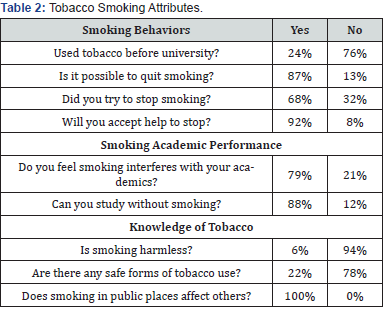
Our study shows that the most used tobacco product is the cigarette (54%), followed by shisha (20%), while the least used product was pipe tobacco (8%). It has been reported in several studies that the use of tobacco products may interfere with the academic performance of students. In our study, 79% claimed that the use of tobacco impacts their academic performance. Some of the reasons given for this trend include addiction, financial burden, lack of concentration, and poor health associated with smoking tobacco. However, despite their claims that it impacts their academic performance, 88% recounted that they can study without smoking. To determine the reasons for smoking and other smoking attributes, we collected data on the use of tobacco before university education. A majority of 76% did not use tobacco before the start of their university education. Also, 13% feel it is not possible to quit the use of tobacco while 92% will accept help to smoke smoking if made available. As regards the knowledge of the health impact of tobacco, 94% acknowledged that it is a harmful practice and that there is no safe form of tobacco. Numerous studies worldwide demonstrate the lack of awareness of the dangers of secondhand smoke and its many health effects [7]. The survey results show that the knowledge of tobacco products and their adverse health effects varies among respondents from different studies and scientific fields. Students from medical and health sciences had the highest knowledge level, while students from technical studies had the lowest knowledge level. Thus, their knowledge is crucial for the national tobacco control strategy [8,9]. Regarding knowledge levels, several previous studies have shown that active smokers have inadequate knowledge about the harmful effects of smoking, suggesting that improving knowledge levels positively impacts smoking prevalence (Majek et al., 2021). Although smokers consider the allegedly less harmful alternative tobacco products to be relatively safe, the need to educate smokers about the risks of alternatives to conventional cigarettes and to regulate the marketing and advertising of such options must be emphasized [10].
When asked questions about the health effects of secondhand smoke, the respondents showed moderate knowledge. The most significant proportion of respondents were aware of the harmful effects of secondhand smoke concerning lung cancer and cardiovascular disease (CVD). Considering the association between knowledge and the desire to quit smoking, this study shows that respondents who intend to quit using tobacco products know more than those who do not. The positive association between the intention to quit smoking and knowledge of health risks has been confirmed in studies from Iraq, China, and India [5].
Summary of Findings
Most tobacco smokers are in their mid-twenties and many of these participants started smoking during their university education.
The knowledge of the risks associated with tobacco use is moderate in this study, but the attitude and will to stop is somehow lacking.
Most of the participants claimed that using tobacco impacts their academic performance.
Cigarette is the most commonly tobacco product used.
Conclusion
The use of tobacco is predominant in males but also common in female students. Most of the students who are active smokers started smoking during their university education and it is more common among students of the faculty of engineering which may be attributed to peer pressure and academic stress. The use of tobacco was admitted affecting academic performance significantly. However, the motivation to stop smoking is little among the students, Hence, the high rate of student smokers [11-45].
Recommendations
From the data generated in this study, the following recommendations are provided below.
Launching more educational campaigns and creating a curriculum in all educational institutions that includes information about tobacco and its harmful effects on health is also recommended.
Banning the sale of tobacco and tobacco products on and off campus could be beneficial, as it would help reduce the number of deaths and illnesses caused by smoking.
Contribution to literature: This study’s findings have contributed to an existing body of knowledge that cough and other minor reasons are implicated in tobacco use in this part of the world.
Conflict of Interest: The researchers declare that there was no conflict of interest.
Acknowledgment
There was no conflict of interest among the authors. The researchers appreciated the statistician, participants, and researchers for the time.
References
- Adeloye D, Auta A, Fawibe A, Gadanya M, Ezeigwe N et al. (2019) Current prevalence pattern of tobacco smoking in Nigeria: a systematic review and meta-analysis. BMC Public Health 19(1): 1-14.
- Awopeju OF, Erhabor GE, Awosusi B, Awopeju OA, Adewole OO (2013) Smoking prevalence and attitudes regarding its control among health professional students in South-Western Nigeria. Ann Med Health Sci Res 3(3): 355-360.
- Oyewole BK, Animasahun VJ, Chapman HJ (2018) Tobacco use in Nigeria youth: A systematic review. PLoS One 13(5): e0196362.
- Egbe CO, Bialous SA, Glantz SA (2017) Avoiding “A Massive Spin-Off Effect in West Africa and Beyond": The Tobacco Industry Stymies Tobacco Control in Nigeria. Nicotine Tob Res 19(7): 877-887.
- Itanyi IU, Onwasigwe CN, Ossip D, Uzochukwu BSC, McIntosh S, et al. (2020) Predictors of current tobacco smoking by adolescents in Nigeria: Interaction between school location and socioeconomic status. Tob Induc Dis 18: 13.
- Itanyi IU, Onwasigwe CN, McIntosh S, Bruno T, Ossip D, et al. (2018) Disparities in tobacco use by adolescents in southeast, Nigeria using Global Youth Tobacco Survey (GYTS) approach. BMC Public Health 18: 1-11.
- Park J, Lim MK, Yun EH, Oh JK, Jeong BY, et al. (2018) Influences of Tobacco-Related Knowledge on Awareness and Behavior towards Smoking. J Korean Med Sci 33(47): e302.
- Otufowora A, Liu Y, Egan KL, Varma DS, Striley CW, et al. (2021) Sex Differences in Willingness to Participate in Research Based on Study Risk Level Among a Community Sample of African Americans in North Central Florida. J Immigr Minor Health 23(1): 19-25.
- Neuman M, Bitton A, Glantz S (2002) Tobacco industry strategies for influencing European Community tobacco advertising legislation. Lancet 359(9314): 1323-1330.
- Goel RK, Budak J (2007) Smoking patterns in Croatia and comparisons with European nations. Cent Eur J Public Health 15(3): 110-115.
- Alexopoulos EC, Jelastopulu E, Aronis K, Dougenis D (2010) Cigarette smoking among university students in Greece: A comparison between medical and other students. Environ Health Prev Med 15(2): 115-120.
- Alkhalifah AF, Agarwal P (2020) Cigarette smoking prevalence and awareness of its oral health effects amongst medical students in Qassim Region, Saudi Arabia. Int. J. Community Med Public Health 7(4): 1240-1243.
- Alves RF, Precioso J, Becoña E (2022) Smoking behavior and secondhand smoke exposure among university students in northern Portugal: Relations with knowledge on tobacco use and attitudes toward smoking. Pulmonology 28(3): 193-202.
- Alzahrani SH, Alghamdi RA, Almutairi AM, Alghamdi AA, Aljuhani AA (2021) Knowledge and Attitudes Among Medical Students Toward the Clinical Usage of e-Cigarettes: A Cross-Sectional Study in a University Hospital in Saudi Arabia. Risk Manag Healthc Policy 14: 1969-1984.
- Andreeva TI, Ananjeva GA, Daminova NA, Leontieva TV, Khakimova LK (2016) Smoke-Free Universities Help Students Avoid Establishing Smoking by Means of Facilitating Quitting. Health Promot Perspect 5(4): 241-249.
- Armstrong GW, Veronese G, George PF, Montroni I, Ugolini G (2017) Assessment of Tobacco Habits, Attitudes, and Education Among Medical Students in the United States and Italy: A Cross-sectional Survey. J Prev Med Public Health 50(3): 177-187.
- Beitz JM, Bolton LL (2015) Systematic Reviews and Meta-Analyses-Literature-based Recommendations for Evaluating Strengths, Weaknesses, and Clinical Value. Ostomy Wound Manage 61(11): 26-42.
- Cornelius MD, Day NL (2000) The effects of tobacco use during and after pregnancy on exposed children. Alcohol Res Health 24(4): 242-249.
- Dawood OT, Rashan MA, Hassali MA, Saleem F (2016) Knowledge and perception about health risks of cigarette smoking among Iraqi smokers. J Pharm Bioallied Sci 8(2): 146-151.
- Demographic and Health Surveys (2018) Adult Health: Men and Women who smoke cigarettes’, The DHS program version: 5.3.0.
- Gupta B, Bray F, Kumar N, Johnson NW (2017) Associations between oral hygiene habits, diet, tobacco and alcohol and risk of oral cancer: A case-control study from India. Cancer Epidemiol 51: 7-14.
- Hossain S, Hossain S, Ahmed F, Islam R, Sikder T, Rahman A (2017) Prevalence of Tobacco Smoking and Factors Associated with the Initiation of Smoking among University Students in Dhaka, Bangladesh. Cent Asian J Glob Health 6(1): 244.
- Hsieh CR, Yen LL, Liu JT, Lin CJ (1996) Smoking, health knowledge, and anti-smoking campaigns: An empirical study in Taiwan. J Health Econ 15(1): 87-104.
- Hu T, Yang Z, Li MD (2018) Pharmacological Effects and Regulatory Mechanisms of Tobacco Smoking Effects on Food Intake and Weight Control. J Neuroimmune Pharmacol 13(4): 453-466.
- Igwe CU, David JC, Okuma OA, Njemanze VC (2021) The prevalence, knowledge of health effect and attitude towards smoking among undergraduates in a Nigerian University. Journal of Public Health and Epidemiology 13(1): 22-29.
- Jakobsen GS, Danielsen D, Jensen MP, Vinther JL, Pisinger C, et al. (2021) Reducing smoking in youth by a smoke-free school environment: A stratified cluster randomized controlled trial of Focus, a multicomponent program for alternative high schools. Tob Prev Cessat 7: 42.
- Kaleta D, Polanska K, Wojtysiak P, Szatko F (2017) Involuntary Smoking in Adolescents, Their Awareness of Its Harmfulness, and Attitudes towards Smoking in the Presence of Non-Smokers. Int J Environ Res Public Health 14(10): 1095.
- Khan FM, Hussain SJ, Laeeq A, Awais A, Hussain SF, et al. (2005) Smoking prevalence, knowledge and attitudes among medical students in Karachi, Pakistan. East Mediterr Health J 11(5-6): 952-958.
- Kondo T, Nakano Y, Adachi S, Murohara T (2019) Effects of Tobacco Smoking on Cardiovascular Disease. Circ J 83(10): 1980-1985.
- Laverty AA, Vardavas CI, Filippidis FT (2021) Prevalence and reasons for use of Heated Tobacco Products (HTP) in Europe: An analysis of Eurobarometer data in 28 countries. The Lancet Regional Health – Europe 8: 100159.
- Ivana Marasović Š, Maja V (2020) Prevalence of smoking in Croatia - How to solve the problem?. Acta Med Croat 74(2020): 189-196.
- Omran AR (2005) The epidemiologic transition: a theory of the epidemiology of population change, 1971. Milbank Quarterly 83(4): 731-57.
- Paul Y, Soni N, Vaid R, Basavaraj P, Khuller N (2014) Ill effects of smoking on general and oral health: Awareness among college going students. Journal of Indian Association of Public Health Dentistry 12(1): 47-53.
- Pezzoli M, Lofaro D, Oliva A, Orione M, Cupi D, et al. (2017). Effects of Smoking on Eustachian Tube and Hearing. Int Tinnitus J 21(2): 98-103.
- Pierce JP, White VM, Emery SL (2012) What public health strategies are needed to reduce smoking initiation?. Tob Control 21(2): 258-264.
- Ramseier CA, Aurich P, Bottini C, Warnakulasuriya S, Davis JM (2012) Curriculum survey on tobacco education in European dental schools. Br Dent J 213(7): E12.
- Sansone GC, Raute LJ, Fong GT, Pednekar MS, Quah AC, et al. (2012) Knowledge of health effects and intentions to quit among smokers in India: Findings from the Tobacco Control Policy (TCP) India pilot survey. Int J Environ Res Public Health 9(2): 564-578.
- Sharma I, Chalise S (2018) The Knowledge and Attitude Regarding the Health Effect of Smoking among Secondary Level Students in Nepal. Asian J Humanit Soc Stud 6(2): 83-90.
- Tang W, Yao L, Roetker N S, Alonso A, Lutsey PL, et al. (2016) Lifetime Risk and Risk Factors for Abdominal Aortic Aneurysm in a 24-Year Prospective Study: The ARIC Study. Arterioscler Thromb Vasc Biol 36(12): 2468-2477.
- Tompkins CNE, Burnley A, McNeill A, Hitchman SC (2021) Factors that influence smokers’ and ex-smokers’ use of IQOS: A qualitative study of IQOS users and ex-users in the UK. Tob Control 30(1): 16-23.
- Ufoaroh CU, Anyabolu AE, Enemuo EH, Aneke SP, Onwurah CA, et al. (2021) Prevalence and Pattern of Smoking among Health Science Students in Nnamdi Azikiwe University Nigeria. West Afr J Med 38(9): 871-876.
- Wamamili B,Wallace-Bell M, Richardson A, Grace RC, Coope P (2019) Cigarette smoking among university students aged 18-24 years in New Zealand: Results of the first (baseline) of two national surveys. BMJ Open 9(12): e032590.
- Waziry R, Jawad M, Ballout RA, Al Akel M, Akl EA (2017) The effects of waterpipe tobacco smoking on health outcomes: an updated systematic review and meta-analysis. Int J Epidemiol 46(1): 32-43.
- Xiao L, Di X, Nan Y, Lyu T, Jiang Y (2020) Cigarette Package Warnings for Adult Smoking Cessation-China, 2018. China CDC Wkly 2(22): 394-398.
- Yang J, Hammond D, Driezen P, Fong GT, Jiang Y (2010) Health knowledge and perception of risks among Chinese smokers and non-smokers: Findings from the Wave 1 ITC China Survey. Tob Control 19(2): i18-i23.






























